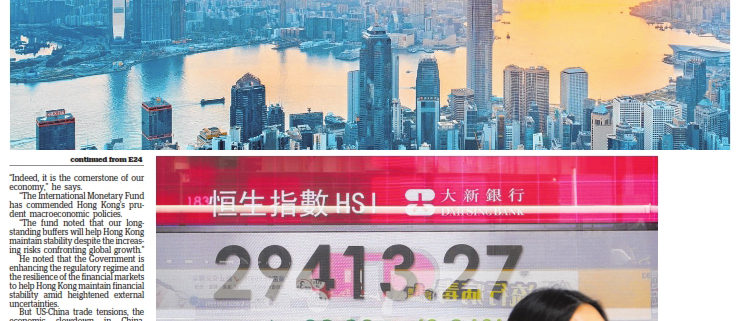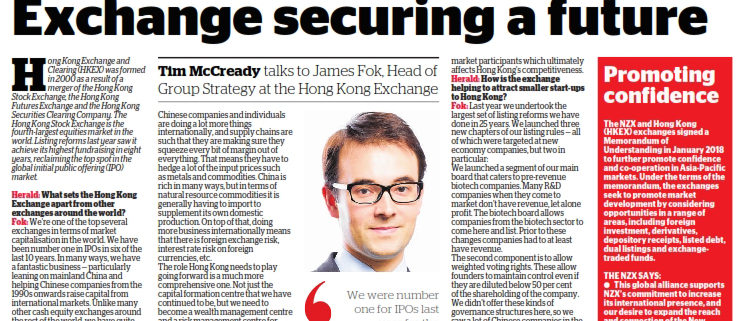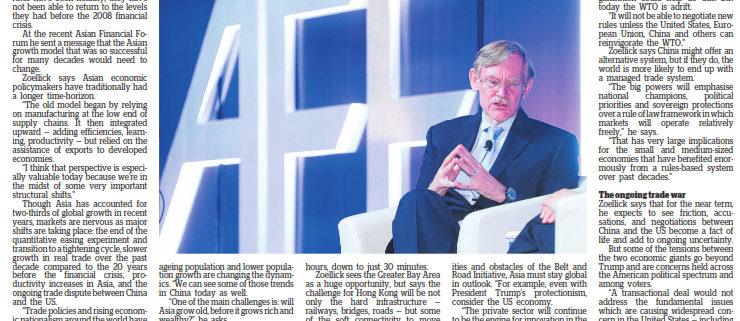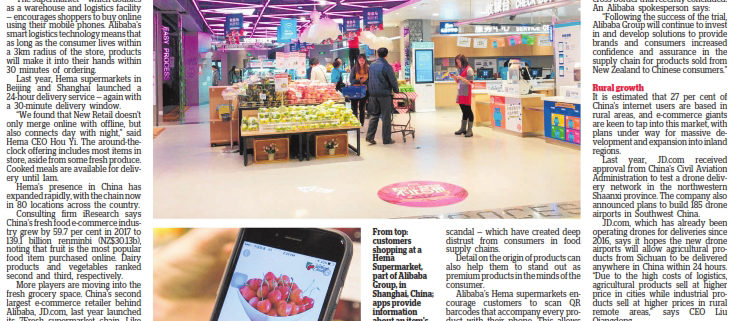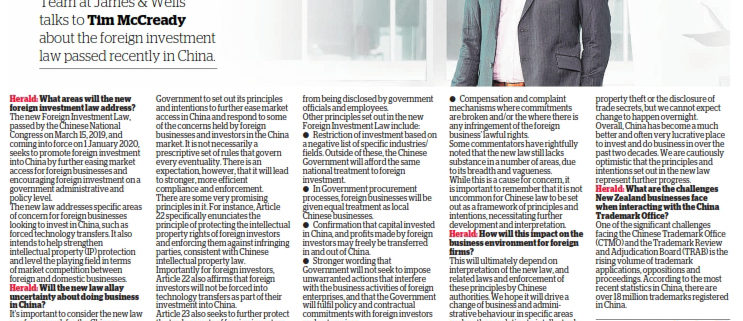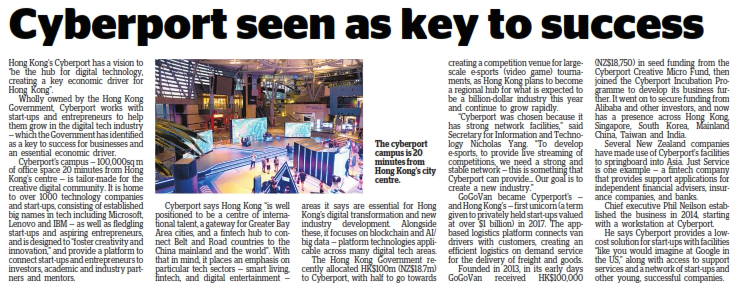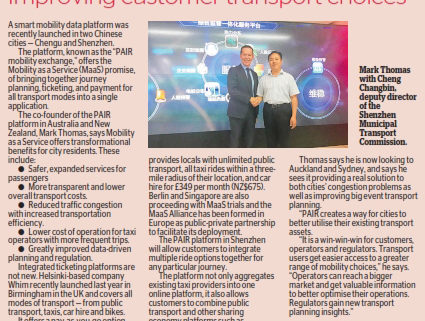China Business: 2019 – Exchange securing a future (NZ Herald)
Tim McCready talks to James Fok, Head of Group Strategy at the Hong Kong Exchange
Herald: What sets the Hong Kong Exchange apart from other exchanges around the world?
Fok: We’re one of the top several exchanges in terms of market capitalisation in the world. We have been number one in IPOs in six of the last 10 years. In many ways, we have a fantastic business — particularly leaning on mainland China and helping Chinese companies from the 1990s onwards raise capital from international markets. Unlike many other cash equity exchanges around the rest of the world, we have quite a lot of growth in our core business. While in New York you’re seeing the number of listed companies fall year-on-year, we’re seeing the number of listed companies go up.
Going back almost 10 years now, we recognise that mainland China is also changing in the way in which it operates and is structured. The first H-share company [companies incorporated in mainland China that are traded on the Hong Kong Stock Exchange] to IPO on the exchange was Tsingtao Brewery Group in 1993. At that time there wasn’t a lot of capital in China, so if Chinese companies wanted to raise capital they had to come out into international markets, and Hong Kong was a place that enabled them to do that.
Herald: With China opening up over past decades, how has the Exchange’s relationship with China changed?
Fok: Today there is a huge surplus of capital in China — notwithstanding the economy slowing down. There is over US$25 trillion sitting in Chinese deposit accounts that has not been deployed into capital markets. We still see a big opportunity with China, not necessarily with Chinese companies coming out to raise capital — although they are continuing to do that — but to try and find a way for Chinese investors to be able to diversify their investment in international markets.
Chinese financial market needs are also becoming a lot more complex. Chinese companies and individuals are doing a lot more things internationally, and supply chains are such that they are making sure they squeeze every bit of margin out of everything. That means they have to hedge a lot of the input prices such as metals and commodities. China is rich in many ways, but in terms of natural resource commodities it is generally having to import to supplement its own domestic production. On top of that, doing more business internationally means that there is foreign exchange risk, interest rate risk on foreign currencies, etc.
The role Hong Kong needs to play going forward is a much more comprehensive one. Not just the capital formation centre that we have continued to be, but we need to become a wealth management centre and a risk management centre for China as well. International investors coming here continue to come here for the Chinese exposure. They now have the option of going to the mainland directly, but many still find challenges in going directly onshore.
Now, as well as bringing Chinese companies here directly to list, the exchange is helping to provide a channel in which investors on both sides of the border can access each other’s market without the product or company being directly listed there.
We are providing a gateway for people to go in using their broker in Hong Kong — without having to open new accounts onshore — allowing access to the onshore market in as frictionless way as is possible, where we manage the differences in market structure.
Equity is still a large piece of the business, but more and more we have been shifting towards different asset classes as well — the most obvious was our acquisition of the London Metal Exchange in 2012.
Herald: How are new advances in fintech reshaping how you’re operating?
Fok: Stock exchanges are the original fintech businesses. Technology has driven our business for a very long time. But what seems to be happening at the moment in the technology space is that we have a confluence of factors that are forcing a huge acceleration in the pace of change.
That change, in many ways, has been hugely disruptive. You only have to look at retail businesses and what Amazon has done to those to understand that. When you look at stock exchanges and you look at the fundamental business model — providing a centralised place for people to buy and sell securities — generally that model is very efficient. But in every other facet of our business — ranging from clearing and settlement, the ways companies communicate with their investors, through to the day-to-day operational processes — that is now disrupted.
When you look at the ability of robotics and artificial intelligence to replace a lot of fairly menial — and actually relatively sophisticated but process-driven jobs — it’s phenomenal. We have had to, like everyone else, look at how we adopt technology into our business to drive efficiency.
Many businesses do this as a way to cut costs. There is an element to which that is true for us, but actually it goes much beyond that. Because everyone investing in our market has to use us, if we are inefficient as a market and as an infrastructure, it imposes a significant cost on all the market participants which ultimately affects Hong Kong’s competitiveness.
Herald: How is the exchange helping to attract smaller start-ups to Hong Kong?
Fok: Last year we undertook the largest set of listing reforms we have done in 25 years. We launched three new chapters of our listing rules — all of which were targeted at new economy companies, but two in particular:
We launched a segment of our main board that caters to pre-revenue biotech companies. Many R&D companies when they come to market don’t have revenue, let alone profit. The biotech board allows companies from the biotech sector to come here and list. Prior to these changes companies had to at least have revenue.
The second component is to allow weighted voting rights. These allow founders to maintain control even if they are diluted below 50 per cent of the shareholding of the company. We didn’t offer these kinds of governance structures here, so we saw a lot of Chinese companies in the tech space find themselves in the US market.
We were number one for IPOs last year for the amount of money raised, and 32 per cent of that money raised came from companies listing under the new chapters.
Herald: The Hong Kong Exchange signed a Memorandum of Understanding with the NZX early last year. What was the purpose of this for the HKEX?
Fok: The long-term ambition for us is to develop the product offering in Hong Kong more widely. It is largely an equities market still today, and when you look at trading and market capitalisation, something like 80 per cent of turnover is on mainland Chinese companies. While this is precisely what attracts international investors, as we open up to more direct mainland China investors who already have a lot of China product to invest in onshore, we need to diversify our offering.
New Zealand isn’t the only country we have signed an MoU with.
Of course, on the stock side, New Zealand is not one of the highest priority markets — most Chinese investors looking to diversify will look to the US market. Instead, the purpose is to bring a more diverse range of products to the exchange. New Zealand has done very well in the agricultural milk future space — something that is potentially of relevance to mainland Chinese consumers, particularly given their consumption.
Promoting confidence
The NZX and Hong Kong (HKEX) exchanges signed a Memorandum of Understanding in January 2018 to further promote confidence and co-operation in Asia-Pacific markets. Under the terms of the memorandum, the exchanges seek to promote market development by considering opportunities in a range of areas, including foreign investment, derivatives, depository receipts, listed debt, dual listings and exchange-traded funds.
The NZX says:
- This global alliance supports NZX’s commitment to increase its international presence, and our desire to expand the reach and connection of the New Zealand market, because growth in New Zealand’s public markets will come from having a wider range of listed products and increased market activity. Global alliances we initiated and are continuing to build with the Hong Kong, Singapore, Shanghai and Nasdaq exchanges support this.
- NZX and HKEX have continued to work together since the memorandum was signed in January 2018. In April, NZX Regulation recognised the regulatory regimes and requirements for the Hong Kong, Singapore and Toronto exchanges. This allows companies listed on these exchanges to seek a secondary listing on NZX.
- Seeking new ways to retain and attract customers has been a priority for NZX. It is vital to growing New Zealand’s public markets. Over the past 12 months, we progressed alliances with global peers to ensure that an NZX listing connects New Zealand issuers with the world.
- Our relationships with the Nasdaq, Singapore, Hong Kong and Shanghai exchanges, and the transformation in our service offering to issuers, ensures we are developing a product that is relevant and competitive.
China Business: Why you can’t contain China (NZ Herald)
We’re in the midst of important structural shifts, says former World Bank President Robert Zoellick. Tim McCready reports
“China has had enormous progress over 40 years. It has had the most historic reduction of poverty in humankind,” says former World Bank President Robert Zoellick.
Zoellick, who led the World Bank through the global financial crisis and served as a US trade representative under President George W. Bush, points out that while Asian growth rates have been healthy, they have not been able to return to the levels they had before the 2008 financial crisis.
At the recent Asian Financial Forum he sent a message that the Asian growth model that was so successful for many decades would need to change.
Zoellick says Asian economic policymakers have traditionally had a longer time-horizon.
“The old model began by relying on manufacturing at the low end of supply chains. It then integrated upward — adding efficiencies, learning, productivity — but relied on the assistance of exports to developed economies.
“I think that perspective is especially valuable today because we’re in the midst of some very important structural shifts.”
Though Asia has accounted for two-thirds of global growth in recent years, markets are nervous as major shifts are taking place: the end of the quantitative easing experiment and transition to a tightening cycle, slower growth in real trade over the past decade compared to the 20 years before the financial crisis, productivity increases in Asia, and the ongoing trade dispute between China and the US.
“Trade policies and rising economic nationalism around the world have disrupted commerce and created a great deal of uncertainty,” says Zoellick.
“Traditionally, governments put tariffs on final goods, but from 2010 to 2016 they focused on temporary trade barriers, targeting cross-border supply chains for raw materials and components.”
But while President Donald Trump’s hefty tariffs may have been intended to help US manufacturers by making foreign goods comparatively more expensive, in reality, import taxes imposed on intermediate goods like steel and aluminium are pushing up prices of products manufactured in the US.
Belt and Road part of a new era
Zoellick says Japan, South Korea and Taiwan all offer cautionary tales — a bias towards incumbency and instrumentalisation has slowed the innovation process — and a rapidly ageing population and lower population growth are changing the dynamics. “We can see some of those trends in China today as well.
“One of the main challenges is: will Asia grow old, before it grows rich and wealthy?” he asks.
He says the new Asian model will need to focus on new and different types of supply chains, to meet the changing needs — first off — of the region itself.
He points to the Greater Bay Area as an example of how this transformation has already started in Hong Kong and China.
The Greater Bay initiative, established by the Chinese Government, links Hong Kong, Macau, and nine other cities within the Guangdong Province into an integrated economic and business cluster.
The 11 cities have a combined population of close to 68 million people — greater than the world’s largest city cluster of 44 million in Tokyo — and a GDP of around US$1.4 trillion (NZ$2.06 trillion).
The 55km Hong Kong-Zhuhai-Macau bridge-tunnel system which opened last year cut the drive time between the cities from up to three hours, down to just 30 minutes.
Zoellick sees the Greater Bay Area as a huge opportunity, but says the challenge for Hong Kong will be not only the hard infrastructure — railways, bridges, roads — but some of the soft connectivity to move capital, information, and people.
“Policies will have to focus on new cross-border logistics networks and the barriers that impede them, such as new infrastructure to facilitate trade, services, environmental conditions, energy access, standards, rules and a whole series of soft infrastructure issues, such as customs and tax procedures,” he says.
Zoellick says China’s Belt and Road Initiative could be an important part of the new Asian model — if it is correctly developed.
“Frankly, the world is still unclear about the real purpose of Belt and Road. Is it a move for geopolitical dominance across Asia?
“Is it a plan to export overproduction from some of the materials industries in China? Or is it a new corridor for development? How will other countries benefit?”
He says although it is important to focus on the new regional opportunities and obstacles of the Belt and Road Initiative, Asia must stay global in outlook. “For example, even with President Trump’s protectionism, consider the US economy.
“The private sector will continue to be the engine for innovation in the United States — whether it is big data, different business models, or biologics in medicines — Asia must keep linked into that to remain competitive and adaptive.”
A trade leadership vacuum
Zoellick says another important factor shaping trade in Asia is the way President Trump has seen the US abandon its previous role as a key player developing new rules for global trade.
“After some 70 years of a US-led system, I suspect that much of the world has taken the public good aspect for granted,” he says.
“People sometimes reacted against US behaviour and didn’t always agree with it, but because the United States is an innovative economy working at the cutting edge, US officials had to press for new norms and rules to help adapt the international system — in areas such as services, intellectual property rights, transparency, anti-corruption, investment, and even currency manipulation.
“When you consider developments in big data, along with things like personal sensors and innovation in medicines, they can have huge effects on health and are significant business opportunities — but only if the world develops the appropriate legal framework.
“Traditionally, the World Trade Organisation could help do this. But today the WTO is adrift.
“It will not be able to negotiate new rules unless the United States, European Union, China and others can reinvigorate the WTO.”
Zoellick says China might offer an alternative system, but if they do, the world is more likely to end up with a managed trade system.
“The big powers will emphasise national champions, political priorities and sovereign protections over a rule of law framework in which markets will operate relatively freely,” he says.
“That has very large implications for the small and medium-sized economies that have benefited enormously from a rules-based system over past decades.”
The ongoing trade war
Zoellick says that for the near term, he expects to see friction, accusations, and negotiations between China and the US become a fact of life and add to ongoing uncertainty.
But some of the tensions between the two economic giants go beyond Trump and are concerns held across the American political spectrum and among voters.
“A transactional deal would not address the fundamental issues which are causing widespread concern in the United States — including questions about the Belt and Road Initiative and the ‘Made in China 2025’ strategy, which has created anxiety that China intends to dominate advanced technology.
“These concerns are part of the political debate in the US,” he says. “The US cannot decouple from or contain China, but it can work together with China to make sure the rules are followed.”
Zoellick says that although Trump is a protectionist by nature, he will be sensitive to the market.
As he begins to think about his re-election — and particularly if the US economy slows down — he is more likely to do a deal.
“However, if there is a deal, I think we have to recognise that it is more likely to be a truce than a solution,” Zoellick says. “Part of my concern is that I’m not sure President Trump thinks in systemic terms. He thinks in deal-making transactional terms.”
China Business: Taking a fresh approach (NZ Herald)
http://bit.ly/2FRKzVM
The fresh food e-commerce business is growing in China as Tim McCready reports
Chinese e-commerce giant Alibaba Group launched the sale of fresh produce in 2016 with the introduction of its Hema supermarket chain. These stores have been established as a test bed for what Alibaba calls the “New Retail” concept: the blurring between shopping online and offline.
In order to keep products fresh, Hema’s fresh grocery items are packaged in small quantities — with just enough food portioned out for a small Chinese family.
The supermarket — which doubles as a warehouse and logistics facility — encourages shoppers to buy online using their mobile phones. Alibaba’s smart logistics technology means that as long as the consumer lives within a 3km radius of the store, products will make it into their hands within 30 minutes of ordering.
Last year, Hema supermarkets in Beijing and Shanghai launched a 24-hour delivery service — again with a 30-minute delivery window.
“We found that New Retail doesn’t only merge online with offline, but also connects day with night,” said Hema CEO Hou Yi. The around-the-clock offering includes most items in store, aside from some fresh produce. Cooked meals are available for delivery until 1am.
Hema’s presence in China has expanded rapidly, with the chain now in 80 locations across the country.
Consulting firm iResearch says China’s fresh food e-commerce industry grew by 59.7 per cent in 2017 to 139.1 billion renminbi (NZ$30.13b), noting that fruit is the most popular food item purchased online. Dairy products and vegetables ranked second and third, respectively.
More players are moving into the fresh grocery space. China’s second-largest e-commerce retailer behind Alibaba, JD.com, last year launched its 7Fresh supermarket chain. Like Hema, 7Fresh focuses on fresh food, and promises 30-minute delivery to locations within 3km of a physical store. During its trial period, JD.com said more than 10,000 customers visited the 7Fresh supermarket each day.
JD.com now plans to open 1000 grocery outlets in the next three to five years.
“Our goal is to expand 7Fresh supermarkets into every first and second-tier city and the surrounding areas of those cities,” says Wang Xiaosong, CEO of 7Fresh.
Another fresh produce e-commerce platform, MissFresh, was founded in 2014, and now operates in 20 Chinese cities, specialising in one-hour deliveries of produce.
In September last year, MissFresh completed its Series D fundraise, raising US$450 million (NZ$661 million) from investors that include Goldman Sachs and Tencent Holdings Ltd.
At the time of the raise, founder and CEO Xu Zheng said MissFresh planned to set up 10,000 front-end warehouses in 100 cities around China, which will allow them to provide one-hour deliveries of fresh produce to 100 million families.
The funds from the raise would be used to develop the company’s supply chain, cold chain logistics infrastructure and its smart retail technology.
Food safety, traceability and provenance
Along with a focus on fresh food and fast delivery, supermarkets in China are placing an increased importance on demonstrating food safety and provenance to consumers.
This stems from various food safety incidents in China — most notably the 2008 melamine milk scandal — which have created deep distrust from consumers in food supply chains.
Detail on the origin of products can also help them to stand out as premium products in the minds of the consumer.
Alibaba’s Hema supermarkets encourage customers to scan QR barcodes that accompany every product with their phone. This allows them to receive further information: including how to prepare it, recipe ideas, and its provenance.
Details of the journey of a fresh food item from farm-to-store can include pictures of the distributor’s business licences and food-safety certificates, information on when a particular crop was harvested and the date the item was delivered to the store. For products that need to be kept at a particular temperature — such as meat and fish — the system can provide details on how cold the inside of the delivery truck was during transit.
To further bolster the confidence customers have in its products, Alibaba joined a consortium of four Australian and New Zealand companies last year, to introduce a food traceability system based on blockchain technology.
The consortium — known as the “Food Trust Framework” — includes New Zealand’s dairy giant Fonterra and New Zealand Post, along with Australia’s Blackmores and Australia Post.
A joint statement said of the initiative: “it will use an immutable central ledger to achieve end-to-end supply-chain traceability and transparency throughout the supply chain to enhance consumer confidence and build a trusted environment for cross-border trade.”
The supply chain traceability cross-border trial recently concluded. An Alibaba spokesperson says:
“Following the success of the trial, Alibaba Group will continue to invest in and develop solutions to provide brands and consumers increased confidence and assurance in the supply chain for products sold from New Zealand to Chinese consumers.”
Rural growth
It is estimated that 27 per cent of China’s internet users are based in rural areas, and e-commerce giants are keen to tap into this market, with plans underway for massive development and expansion into inland regions.
Last year, JD.com received approval from China’s Civil Aviation Administration to test a drone delivery network in the northwestern Shaanxi province. The company also announced plans to build 185 drone airports in Southwest China.
JD.com, which has already been operating drones for deliveries since 2016, says it hopes the new drone airports will allow agricultural products from Sichuan to be delivered anywhere in China within 24 hours. “Due to the high costs of logistics, agricultural products sell at a higher price in cities while industrial products sell at higher prices in rural remote areas,” says CEO Liu Qiangdong.
Alibaba has established a “Rural Taobao” initiative, that aims to sell products to regional customers at urban prices, and create efficient supply chains for rural produce.
As part of the project, Alibaba has established a network of 30,000 e-commerce service centres that enable villagers to purchase products online.
General manager of Rural Taobao Bill Wang says: “We want to improve the living conditions of China’s rural regions. To do so, we need to provide high-quality goods, personalised services, smart logistic solutions and prices comparable to that of the cities.”
These moves from e-commerce giants align with the Chinese Government’s National Strategic Plan for Rural Vitalization from 2018 to 2022, which calls for significant progress in rural rejuvenation. The plan has ambitious goals to close the gap between urban and rural areas, eliminate poverty and improve governance in the countryside.
China Business: Changing landscape (NZ Herald)
http://bit.ly/2YJbnjk
Ye Miao, head of the Asia Team at James & Wells talks to Tim McCready about the foreign investment law passed recently in China.
Herald: What areas will the new foreign investment law address?
The new Foreign Investment Law, passed by the Chinese National Congress on March 15, 2019, and coming into force on 1 January 2020, seeks to promote foreign investment into China by further easing market access for foreign businesses and encouraging foreign investment on a government administrative and policy level.
The new law addresses specific areas of concern for foreign businesses looking to invest in China, such as forced technology transfers. It also intends to help strengthen intellectual property (IP) protection and level the playing field in terms of market competition between foreign and domestic businesses.
Herald: Will the new law allay uncertainty about doing business in China?
It’s important to consider the new law as a framework for the Chinese Government to set out its principles and intentions to further ease market access in China and respond to some of the concerns held by foreign businesses and investors in the China market. It is not necessarily a prescriptive set of rules that govern every eventuality. There is an expectation, however, that it will lead to stronger, more efficient compliance and enforcement.
There are some very promising principles in it. For instance, Article 22 specifically enunciates the principle of protecting the intellectual property rights of foreign investors and enforcing them against infringing parties, consistent with Chinese intellectual property law.
Importantly for foreign investors, Article 22 also affirms that foreign investors will not be forced into technology transfers as part of their investment into China.
Article 23 also seeks to further protect the trade secrets of foreign investors from being disclosed by government officials and employees.
Other principles set out in the new Foreign Investment Law include:
- Restriction of investment based on a negative list of specific industries/fields. Outside of these, the Chinese Government will afford the same national treatment to foreign investment.
- In Government procurement processes, foreign businesses will be given equal treatment as local Chinese businesses.
- Confirmation that capital invested in China, and profits made by foreign investors may freely be transferred in and out of China.
- Stronger wording that Government will not seek to impose unwarranted actions that interfere with the business activities of foreign enterprises, and that the Government will fulfil policy and contractual commitments with foreign investors and enterprises.
- Compensation and complaint mechanisms where commitments are broken and/or the where there is any infringement of the foreign business’ lawful rights.
Some commentators have rightfully noted that the new law still lacks substance in a number of areas, due to its breadth and vagueness.
While this is a cause for concern, it is important to remember that it is not uncommon for Chinese law to be set out as a framework of principles and intentions, necessitating further development and interpretation.
Herald: How will this impact on the business environment for foreign firms?
This will ultimately depend on interpretation of the new law, and related laws and enforcement of these principles by Chinese authorities. We hope it will drive a change of business and administrative behaviour in specific areas such as those relating to intellectual property theft or the disclosure of trade secrets, but we cannot expect change to happen overnight.
Overall, China has become a much better and often very lucrative place to invest and do business in over the past two decades. We are cautiously optimistic that the principles and intentions set out in the new law represent further progress.
Herald: What are the challenges New Zealand businesses face when interacting with the China Trademark Office?
One of the significant challenges facing the Chinese Trademark Office (CTMO) and the Trademark Review and Adjudication Board (TRAB) is the rising volume of trademark applications, oppositions and proceedings. According to the most recent statistics in China, there are over 18 million trademarks registered in China.
In 2018 alone, the CTMO received almost 7.4 million applications and examined over 8 million.
That represents over 20,000 applications and 22,000 examinations per day.
This puts immense pressure on the CTMO to both process the applications quickly and to act by the book, and has resulted in examiners often taking very conservative positions. Very prescriptive interpretations are taken where there are prior marks that include even minor similarities with the applied for trademark, which means an estimated 50 per cent or more of all applications are now rejected in the first instance. Applicants then have just 15 days to respond.
Therefore, it’s important for a business to consider its options in depth and to engage a trademark professional to assess the examination report and respond to it by the deadline. Often, objections can be overcome at the TRAB appeal level where there is more time for examiners to consider the applications and evidence in support, or through other actions.
Where the TRAB issues an unfavourable decision, an appeal can still be made to the Beijing IP Court. Unfortunately, however, these processes can be time-consuming and costly, so it is worthwhile to have back-up plans and an overall strategy in place. Unfortunately, the high volume of applications can mean that your potential brand (words and logos) may already be taken by someone else. As such, it is wise to consider checking the availability of your brand as trademarks in the development stage of your branding, so that you don’t overcommit on a brand that you may not be able to use or register in your chosen markets.
Herald: How do you see the long-term outlook for IP protection in China?
China has been updating and improving its intellectual property laws and process over the past decade, and it is continually doing so. For instance, it is currently in the process of updating its patent laws, and has recently had high-level discussions as to its trademark laws and processes. These discussions have involved IP professionals as well as businesses.
While there are still frustrating processes and wait times, the overall goals of the IP authorities are admirable.
They have sought to recruit more examiners to help reduce examination times, set up the Beijing IP court to deal with specific IP matters expediently, and taken drastic steps to reduce trademark squatters.
Herald: Are New Zealand businesses ready to take advantage of the changing opportunities in China?
Some are well-prepared, others less so. In addition to a good product or service, it’s important that New Zealand businesses have a good story, and that they properly assess opportunities in key markets.
We strongly recommend carrying out due diligence in advance of entering China, and engaging someone on the ground with knowledge of your industry or sector.
And of course, we recommend taking early and appropriate steps to protect your IP and trade secrets.
And be mindful of the different cultural forces in play — what works in New Zealand does not necessarily work in other markets like China.
China Business: Cyberport seen as key to success (NZ Herald)
Hong Kong’s Cyberport has a vision to “be the hub for digital technology, creating a key economic driver for Hong Kong”.
Wholly owned by the Hong Kong Government, Cyberport works with start-ups and entrepreneurs to help them grow in the digital tech industry — which the Government has identified as a key to success for businesses and an essential economic driver.
Cyberport’s campus — 100,000sq m of office space 20 minutes from Hong Kong’s centre — is tailor-made for the creative digital community. It is home to over 1000 technology companies and start-ups, consisting of established big names in tech including Microsoft, Lenovo and IBM — as well as fledgling start-ups and aspiring entrepreneurs, and is designed to “foster creativity and innovation,” and provide a platform to connect start-ups and entrepreneurs to investors, academic and industry partners and mentors.
Cyberport says Hong Kong “is well positioned to be a centre of international talent, a gateway for Greater Bay Area cities, and a fintech hub to connect Belt and Road countries to the China mainland and the world”. With that in mind, it places an emphasis on particular tech sectors — smart living, fintech, and digital entertainment — areas it says are essential for Hong Kong’s digital transformation and new industry development. Alongside these, it focuses on blockchain and AI/big data — platform technologies applicable across many digital tech areas.
The Hong Kong Government recently allocated HK$100m (NZ$18.7m) to Cyberport, with half to go towards creating a competition venue for large-scale e-sports (video game) tournaments, as Hong Kong plans to become a regional hub for what is expected to be a billion-dollar industry this year and continue to grow rapidly.
“Cyberport was chosen because it has strong network facilities,” said Secretary for Information and Technology Nicholas Yang. “To develop e-sports, to provide live streaming of competitions, we need a strong and stable network — this is something that Cyberport can provide… Our goal is to create a new industry.”
GoGoVan became Cyperport’s — and Hong Kong’s — first unicorn (a term given to privately held start-ups valued at over $1 billion) in 2017. The app-based logistics platform connects van drivers with customers, creating an efficient logistics on demand service for the delivery of freight and goods.
Founded in 2013, in its early days GoGoVan received HK$100,000 (NZ$18,750) in seed funding from the Cyberport Creative Micro Fund, then joined the Cyberport Incubation Programme to develop its business further. It went on to secure funding from Alibaba and other investors, and now has a presence across Hong Kong, Singapore, South Korea, Mainland China, Taiwan and India.
Several New Zealand companies have made use of Cyberport’s facilities to springboard into Asia. Just Service is one example — a fintech company that provides support applications for independent financial advisers, insurance companies, and banks.
Chief executive Phil Neilson established the business in 2014, starting with a workstation at Cyberport.
He says Cyberport provides a low-cost solution for start-ups with facilities “like you would imagine at Google in the US,” along with access to support services and a network of start-ups and other young, successful companies.
China Business: Improving customer transport choices (NZ Herald)
A smart mobility data platform was recently launched in two Chinese cities — Chengu and Shenzhen.
The platform, known as the “PAIR mobility exchange,” offers the Mobility as a Service (MaaS) promise, of bringing together journey planning, ticketing, and payment for all transport modes into a single application.
The co-founder of the PAIR platform in Australia and New Zealand, Mark Thomas, says Mobility as a Service offers transformational benefits for city residents. These include:
- Safer, expanded services for passengers
- More transparent and lower overall transport costs.
- Reduced traffic congestion with increased transportation efficiency.
- Lower cost of operation for taxi operators with more frequent trips.
- Greatly improved data-driven planning and regulation.
Integrated ticketing platforms are not new. Helsinki-based company Whim recently launched last year in Birmingham in the UK and covers all modes of transport — from public transport, taxis, car hire and bikes. It offers a pay-as-you-go option, as well as an unlimited service, which provides locals with unlimited public transport, all taxi rides within a three-mile radius of their location, and car hire for £349 per month (NZ$675). Berlin and Singapore are also proceeding with MaaS trials and the MaaS Alliance has been formed in Europe as a public-private partnership to facilitate its deployment.
The PAIR platform in Shenzhen will allow customers to integrate multiple ride options together for any particular journey.
The platform not only aggregates existing taxi providers into one online platform, it also allows customers to combine public transport and other sharing economy platforms such as e-scooters to get to their destination.
Thomas says he is now looking to Auckland and Sydney, and says he sees it providing a real solution to both cities’ congestion problems as well as improving big event transport planning.
“PAIR creates a way for cities to better utilise their existing transport assets.
“It is a win-win-win for customers, operators and regulators. Transport users get easier access to a greater range of mobility choices,” he says. “Operators can reach a bigger market and get valuable information to better optimise their operations. Regulators gain new transport planning insights.”


